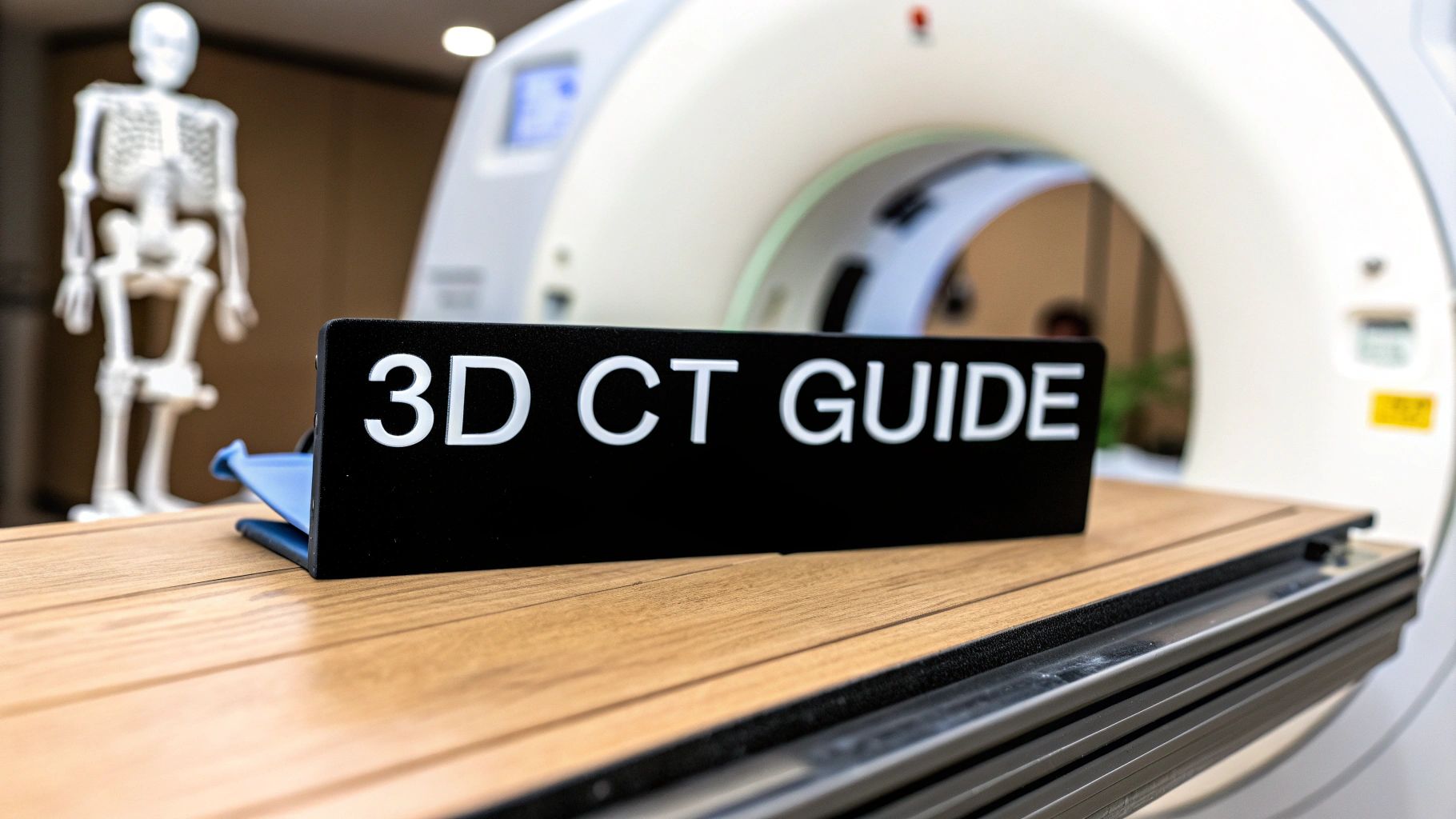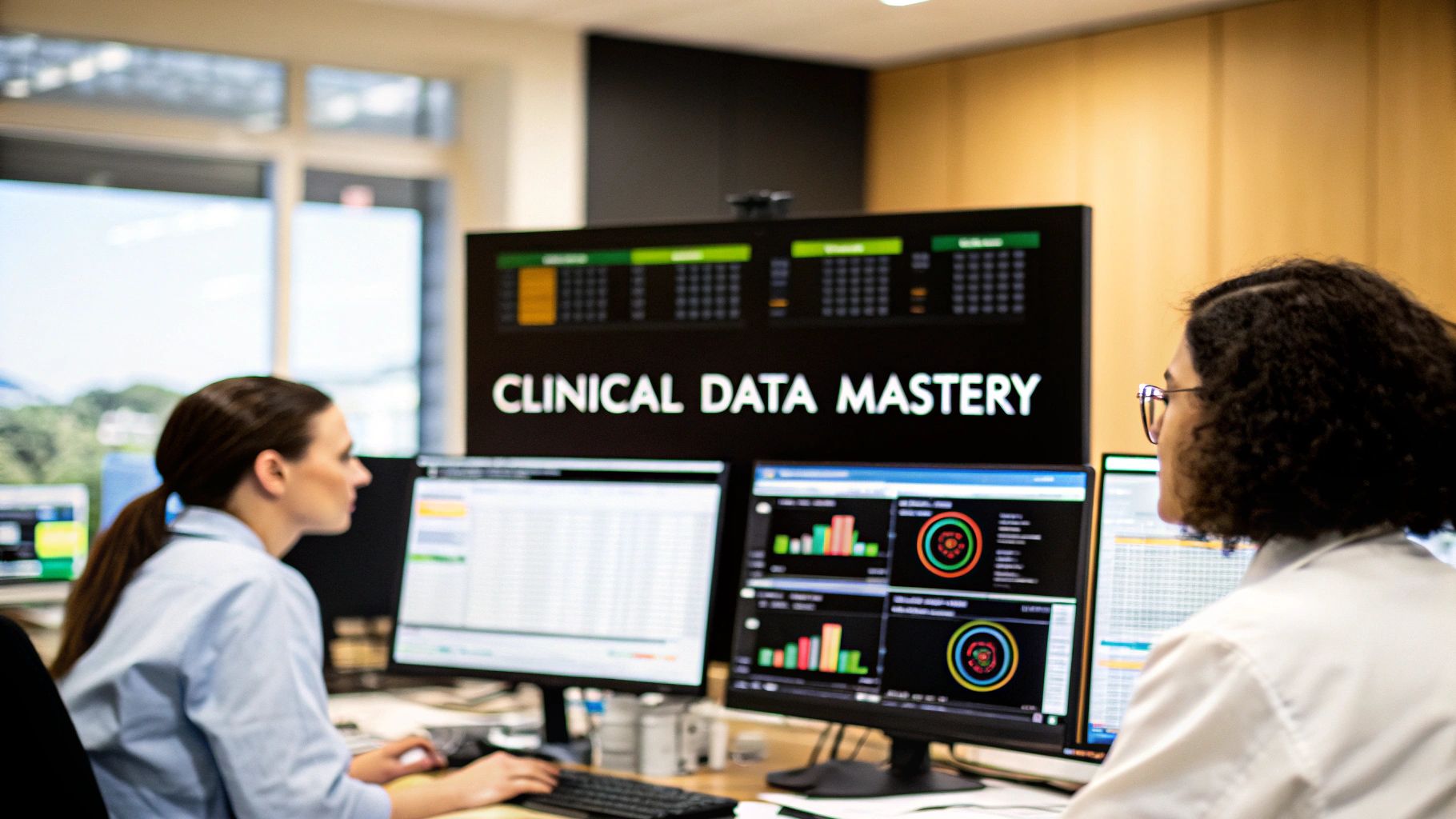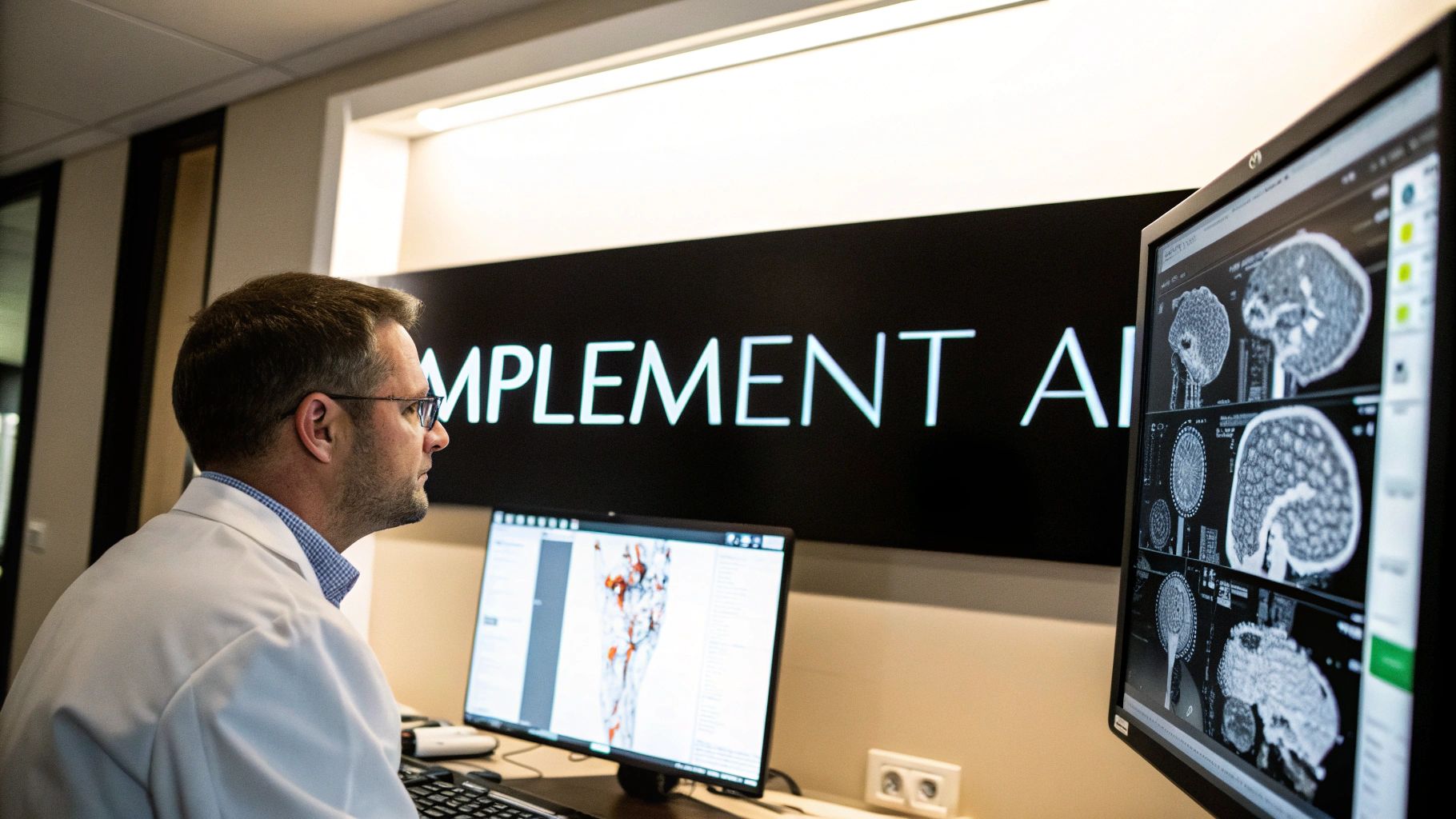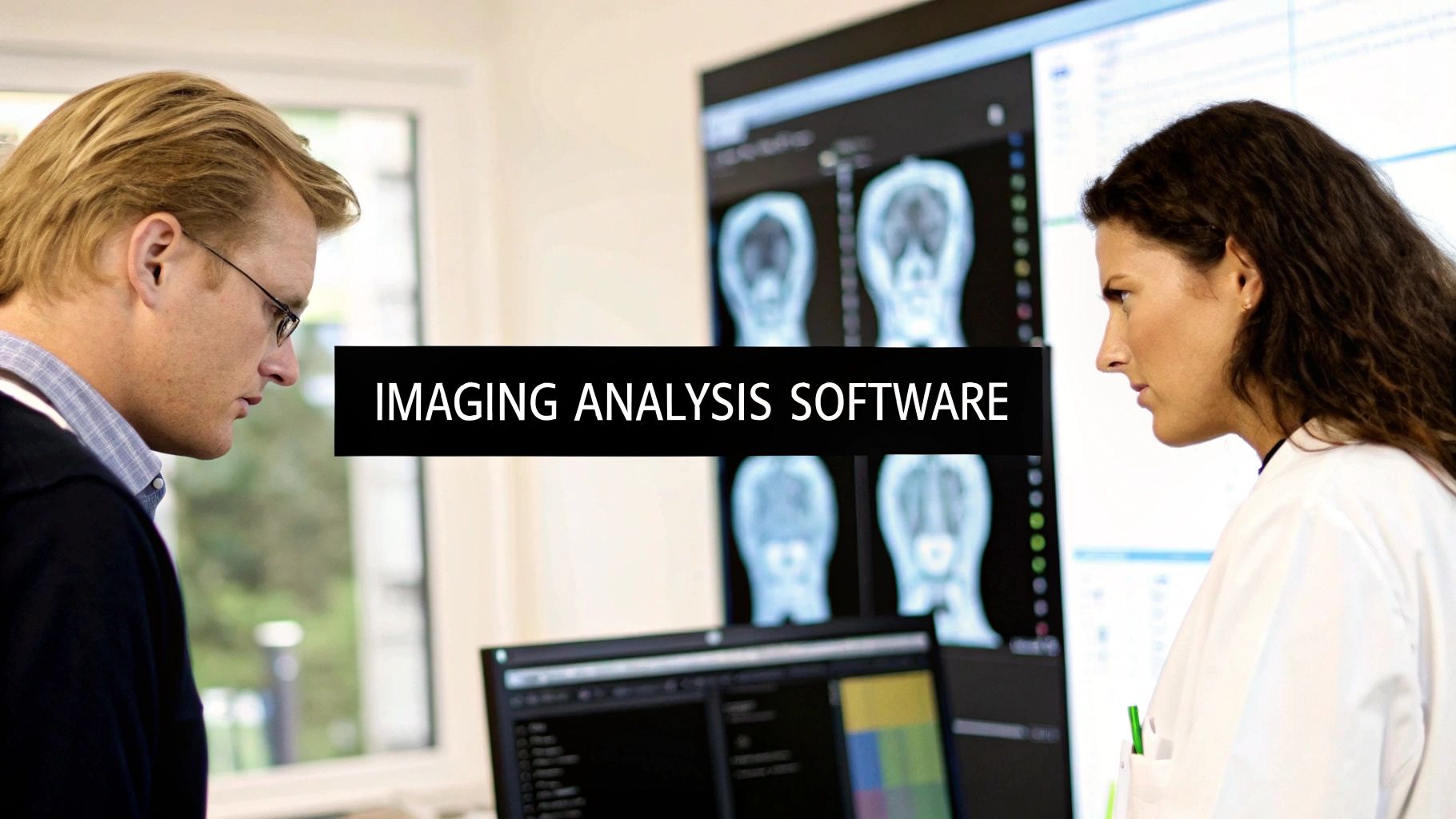The New Era of Visual Intelligence in Healthcare
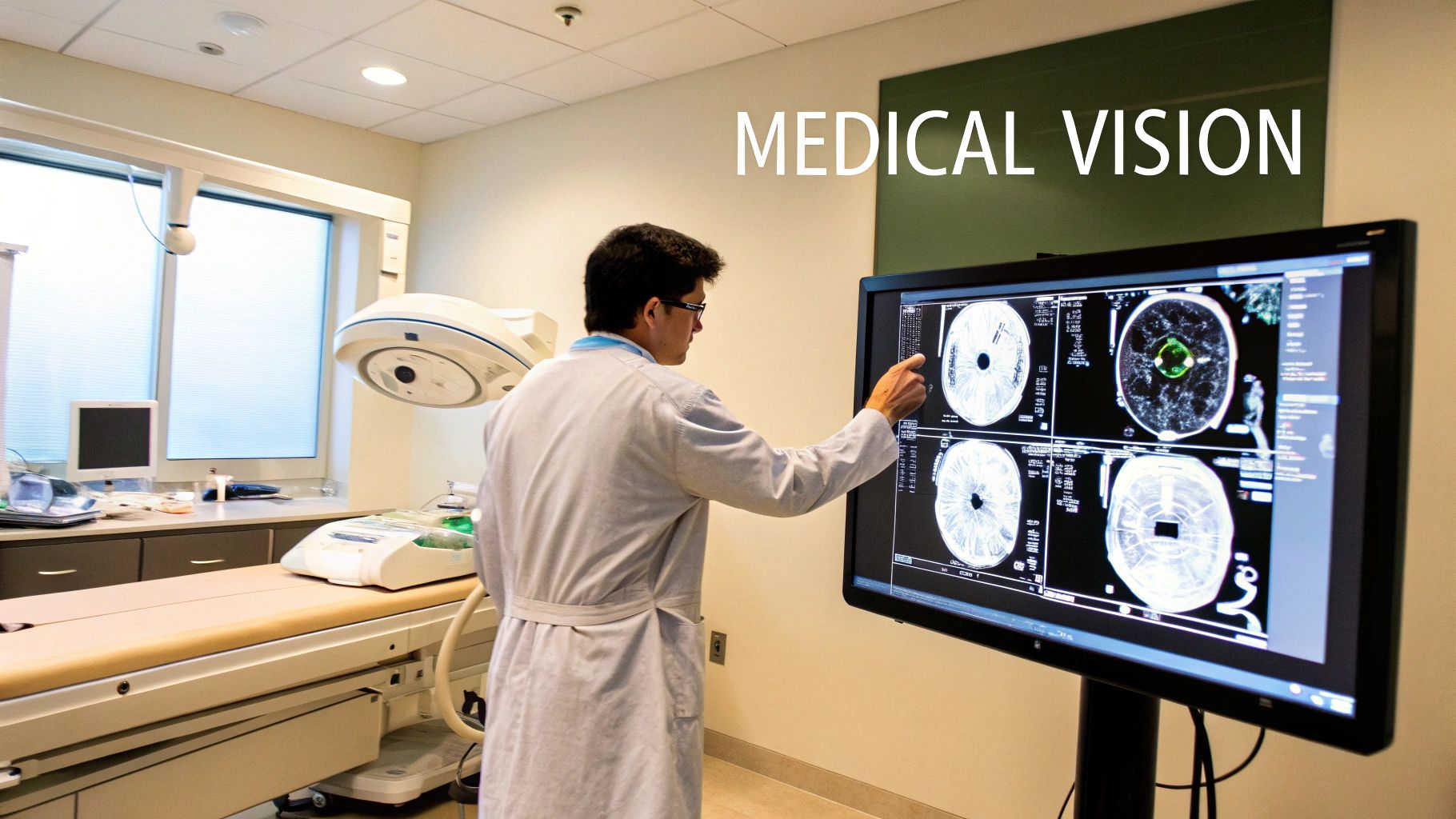
The medical imaging landscape is rapidly evolving thanks to computer vision. This technology, powered by AI and deep learning, is transforming how we approach diagnostics. Platforms like iClinics offer innovative solutions in this space. This shift is critical in addressing the growing volume of medical images and the simultaneous shortage of healthcare professionals.
Computer Vision: A Powerful Diagnostic Tool
Computer vision shines in medical imaging because of its pattern recognition abilities. These algorithms can detect subtle anomalies often missed by the human eye, leading to earlier and more accurate diagnoses. This applies to a wide range of imaging modalities, including X-rays, MRIs, CT scans, and ultrasounds. It's a significant advancement in disease diagnosis.
This transformation is fueling impressive market growth. The market for computer vision in healthcare is expected to surge from USD 1.4 billion in 2023 to a staggering USD 49.0 billion by 2032. This represents a remarkable CAGR of 47.8%. In 2023, medical imaging and diagnostics accounted for over 50% of global computer vision revenue in healthcare. Hospitals and clinics generated over 55% of this revenue. This rapid growth underscores the increasing adoption of AI and deep learning to improve diagnostic accuracy and efficiency, ultimately benefiting patients. Find more detailed statistics here.
Impact Across Imaging Modalities
Computer vision contributes significantly across diverse imaging modalities. In radiology, it helps detect subtle fractures, identify small lung nodules, and locate brain abnormalities. This leads to faster and more accurate diagnoses, essential for effective treatment planning.
Computer vision is also enhancing other medical specialties. In cardiology, it assists in predicting cardiovascular events before traditional symptoms appear. In oncology, it's revolutionizing tumor detection and treatment monitoring. This demonstrates the versatility and broad application of this technology in enhancing patient care.
From Pixels to Insights: The Role of Deep Learning
The power of computer vision in medical imaging stems from sophisticated algorithms that analyze visual data. Convolutional Neural Networks (CNNs) and deep learning architectures are central to this progress. These networks are trained to recognize complex patterns in medical images, much like experienced radiologists.
Instead of relying on years of experience, these algorithms learn from extensive datasets of medical images. They can identify subtle features that might be overlooked by human observers, enabling them to support medical professionals in making faster, data-driven diagnostic decisions.
The Future of Visual Diagnosis
Advancements in computer vision continue at a rapid pace. Emerging technologies like multimodal analysis, which combines data from multiple imaging techniques, are creating even more powerful diagnostic tools. Explainable AI is also increasing the transparency and trustworthiness of these systems by revealing their decision-making process.
These ongoing developments promise more precise and personalized diagnostics in the future. As these technologies mature, they will further empower healthcare professionals to deliver better care and improve patient outcomes.
Beyond Human Vision: Breaking Diagnostic Boundaries

Computer vision in medical imaging is not simply about making pictures clearer; it's about uncovering details previously hidden from view. This technology is driving tangible advancements in diagnostics, expanding the realm of possibilities in patient care. For instance, AI systems now detect early signs of cancers, subtle neurological changes, and cardiovascular irregularities with impressive accuracy.
These breakthroughs are transforming how medical professionals diagnose and treat diseases.
Computer-Aided Diagnosis: A Collaborative Approach
Computer-aided diagnosis (CAD) systems are emerging as valuable tools for medical professionals. It's crucial to understand that these systems are designed to work alongside clinicians, not replace them. They serve as a second set of eyes, meticulously examining images for patterns and anomalies that human observers might overlook.
This collaboration boosts diagnostic confidence and leads to better-informed treatment choices. This partnership allows medical experts to combine the strengths of both AI and human skill. AI excels at pattern recognition and processing massive datasets.
Human clinicians bring experience, intuition, and the ability to consider the patient's complete medical background. This combination creates a diagnostic synergy that surpasses either approach working alone.
Quantifiable Improvements in Diagnosis
Computer vision technology is noticeably improving diagnostic accuracy and efficiency. Studies reveal considerable enhancements in medical image analysis, directly influencing disease diagnosis. AI-powered systems analyzing mammograms have, for example, surpassed human radiologists in performance.
This has led to a reduction in both false positives and false negatives, therefore increasing diagnostic reliability. Moreover, these systems have decreased radiologist workload by up to 88%. Learn more about the value of computer vision in healthcare here.
This efficiency is especially valuable considering the anticipated 9% job growth for radiologic and MRI technicians through 2028, as projected by the U.S. Bureau of Labor Statistics. Couple this with the predicted 11.8% growth in the global digital pathology market by 2027, and the benefit becomes clear. Computer vision helps address the escalating demand for medical imaging while alleviating the strain of workforce shortages.
To further illustrate the advantages of computer vision, let's examine a comparison of its performance against traditional human analysis:
Computer Vision vs. Traditional Analysis in Medical Imaging
A comparison of performance metrics between AI-powered computer vision systems and traditional human analysis across different imaging modalities and conditions
| Diagnostic Parameter | Traditional Human Analysis | Computer Vision Analysis | Improvement |
|---|---|---|---|
| Mammogram Accuracy | 85% | 92% | 7% |
| Lung Nodule Detection | 70% | 88% | 18% |
| Diabetic Retinopathy Detection | 80% | 90% | 10% |
| Bone Fracture Detection | 90% | 95% | 5% |
This table highlights the significant gains in accuracy achieved by computer vision across various diagnostic parameters. The improved detection rates across these areas contribute to earlier diagnosis, potentially leading to better patient outcomes.
Leading Hospitals Embrace Computer Vision
Major hospitals are integrating computer vision into their diagnostic processes, with notable results. They are experiencing decreases in both false positives and false negatives, resulting in more accurate diagnoses and more effective treatments. In addition, computer vision is dramatically reducing time-to-diagnosis, a vital factor in urgent medical scenarios.
This expedited diagnosis permits faster intervention, which can greatly enhance patient outcomes. This accelerated process offers many benefits. It eases patient anxiety by delivering answers more quickly, facilitating early treatment initiation, and potentially boosting survival rates for serious conditions.
By streamlining the diagnostic pathway, computer vision improves the overall patient experience and contributes to more effective healthcare delivery. This technology isn’t just changing how we diagnose disease—it's making a profound impact on lives.
Inside the Algorithms Transforming Medical Sight
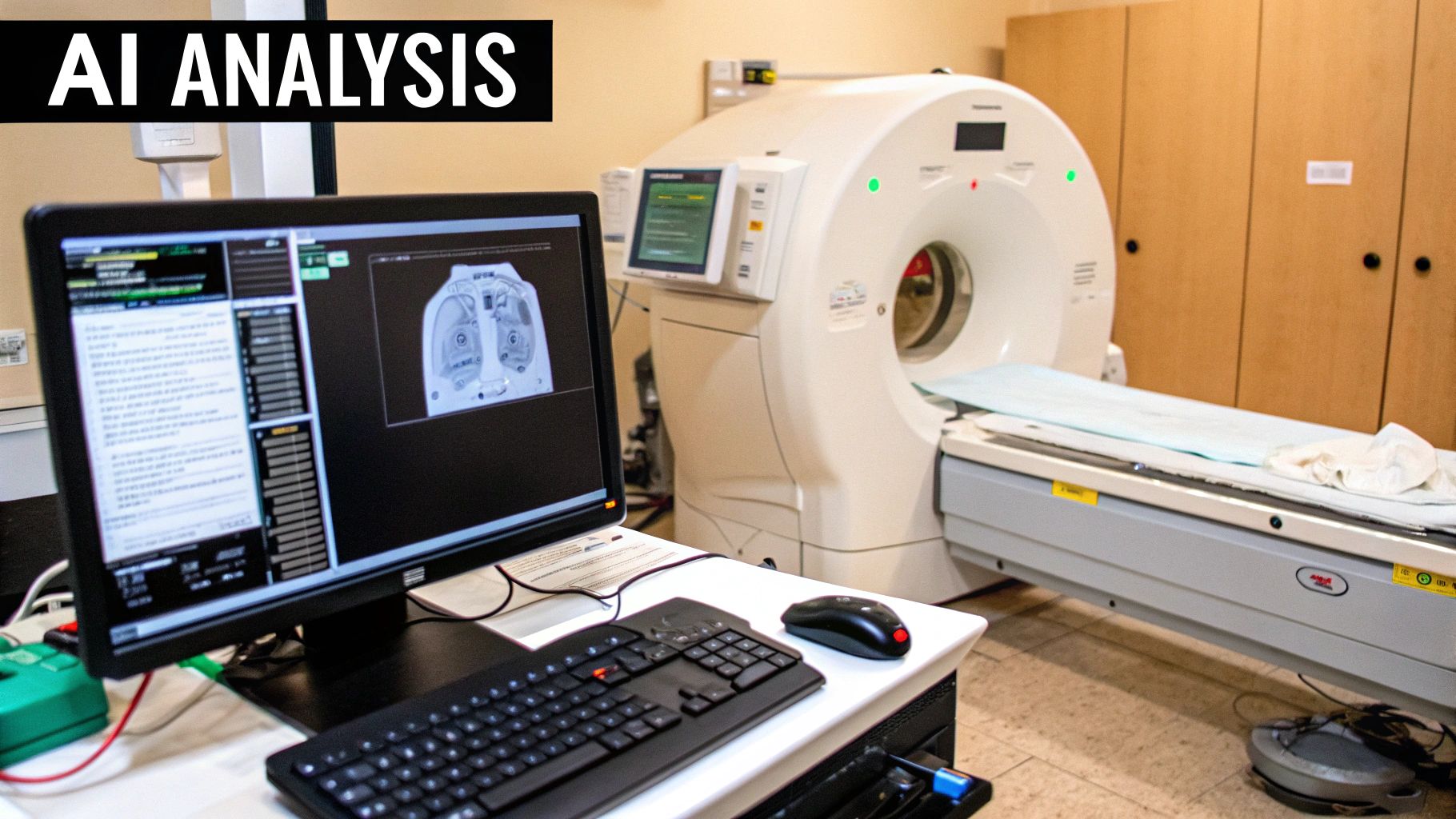
Computer vision is transforming medical imaging with its ability to detect patterns the human eye often misses. This incredible capability relies on complex algorithms and advanced computing architectures. Let's explore the core technologies empowering these systems to interpret visual medical data with such remarkable precision.
Convolutional Neural Networks: The Engine of Visual Recognition
Convolutional Neural Networks (CNNs) are at the heart of many computer vision systems. These networks are designed specifically for processing images. Think of a digital filter scanning an image, extracting key features like edges, textures, and shapes. CNNs operate similarly, learning to recognize intricate patterns layer by layer.
For example, when analyzing a chest X-ray, a CNN might first identify basic lines and edges. Then, it progressively learns to recognize more complex structures like ribs and lungs. Finally, it can even pinpoint subtle anomalies. This layered approach allows CNNs to identify vital details that might go unnoticed by human observation.
Deep Learning Architectures: Unleashing the Power of Data
CNNs are a type of deep learning architecture. Deep learning models excel in medical imaging due to their ability to learn from vast datasets. Trained on thousands of images, they identify subtle patterns associated with specific conditions. Techniques like transfer learning also allow these systems to apply knowledge gained from one imaging context (like X-rays) to another (like CT scans).
This adaptability significantly accelerates the development of computer vision tools. As the system processes more data, it refines its ability to distinguish between healthy and abnormal tissues, leading to more accurate diagnoses and better-informed treatment decisions.
Hardware and Privacy: Enabling Real-Time Analysis
Processing extensive medical image datasets requires significant computing power. Specialized hardware accelerators, such as Graphics Processing Units (GPUs), are essential for enabling real-time analysis, crucial in time-sensitive medical situations.
Data privacy is also paramount. Emerging techniques like federated learning allow algorithms to train on decentralized data sources (like multiple hospitals) without directly sharing sensitive patient information. This protects privacy while fostering collaborative model development. This application of artificial intelligence and computer vision significantly improves medical diagnostics by uncovering hidden patterns often missed by human observers. Learn more about these advancements here.
Training and Validation: Building Robust and Reliable Systems
Developing effective computer vision systems for medical imaging requires meticulous training and validation. Building representative datasets that include diverse patient populations is crucial for ensuring consistent algorithm performance across various demographics and conditions.
Rigorous testing and evaluation are essential for minimizing false positives and false negatives. The ultimate goal is to create robust and reliable systems that empower medical professionals to provide accurate and timely diagnoses, ultimately leading to better patient care.
Transforming Specialties Through Visual Intelligence
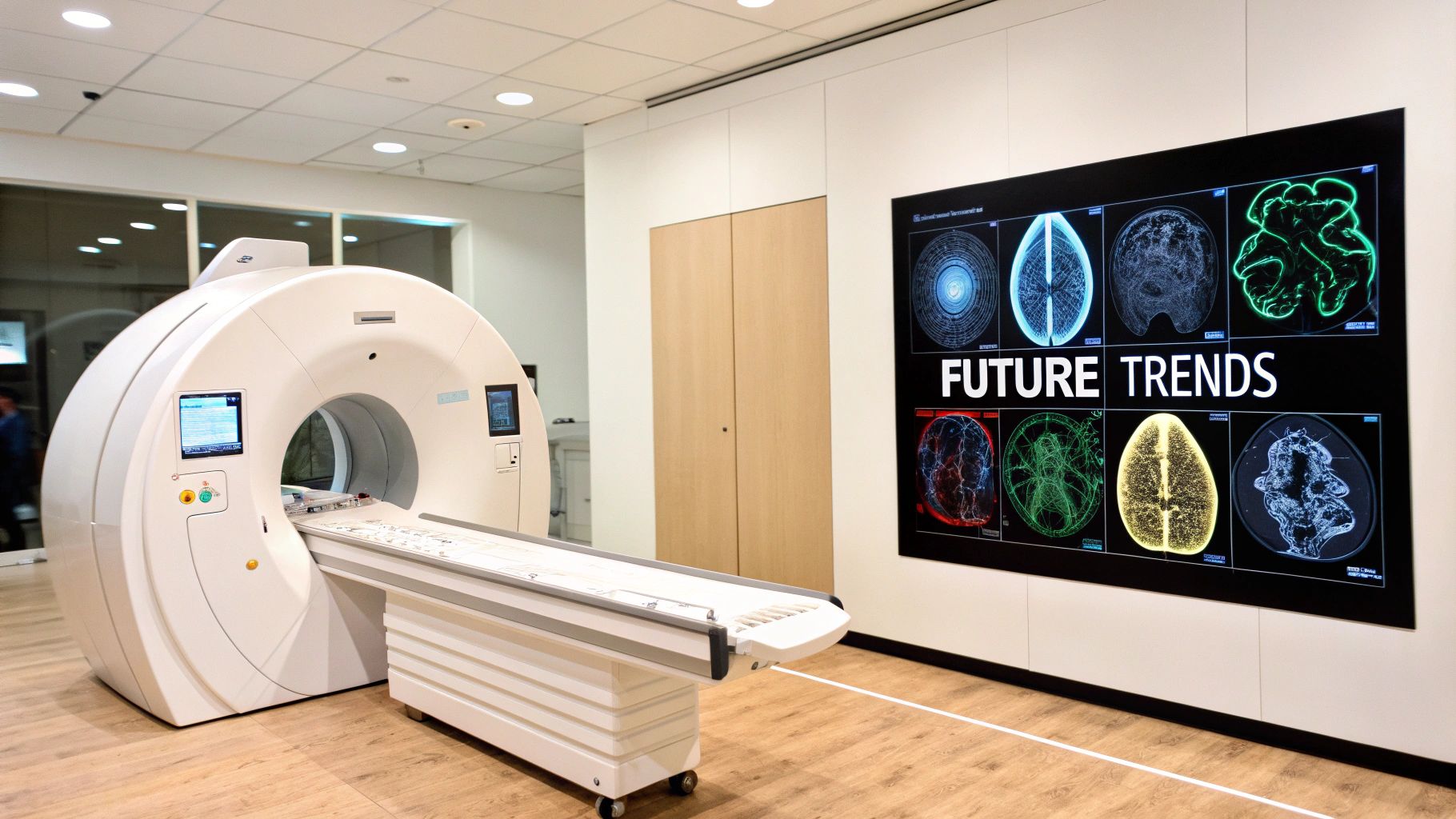
Computer vision is significantly impacting medical diagnostics, extending its reach far beyond radiology. This section explores how this visual intelligence is being implemented across various medical specialties and its positive effects on patient care. Importantly, these advancements are already being deployed in clinical settings, demonstrating measurable improvements.
Radiology: Enhanced Accuracy and Efficiency
Computer vision assists radiologists in detecting subtle issues like small fractures, lung nodules, and brain abnormalities, often with greater accuracy than traditional methods. This leads to earlier and more precise diagnoses, crucial for effective treatment plans. For example, AI-powered systems can analyze mammograms for breast cancer detection, reducing both false positives and false negatives. This increased accuracy allows for more appropriate and timely interventions. Moreover, these systems can decrease radiologist workload, enabling them to focus on complex cases and boosting departmental efficiency.
Cardiology: Predicting Cardiovascular Events
Cardiologists are using computer vision to predict cardiovascular events before traditional symptoms appear. By analyzing medical images, AI algorithms can identify subtle indicators of potential heart problems that might otherwise be missed. This predictive capability enables proactive intervention, potentially preventing serious cardiac events and improving patient outcomes. Early detection is paramount for managing cardiovascular disease and improving long-term health.
Oncology: Revolutionizing Cancer Care
Computer vision plays a crucial role in oncology, particularly in tumor detection and treatment monitoring. AI algorithms can analyze medical images to identify and characterize tumors with remarkable precision, aiding in early diagnosis and treatment planning. Additionally, computer vision can track the effectiveness of cancer treatments by monitoring tumor size and other relevant characteristics. This real-time feedback allows oncologists to adjust treatment strategies as needed, optimizing patient care and improving the chances of successful outcomes.
Expanding Applications Across Specialties
The applications of computer vision in healthcare are continually expanding, with promising advancements in areas like pathology, ophthalmology, dermatology, and emergency medicine.
- Pathology: Computer vision aids in analyzing tissue samples, improving the speed and accuracy of diagnoses.
- Ophthalmology: It helps detect eye diseases like diabetic retinopathy, often before noticeable symptoms appear.
- Dermatology: Computer vision assists in identifying skin cancers and other dermatological conditions.
- Emergency Medicine: It supports rapid diagnosis of critical conditions like strokes and internal bleeding.
These examples showcase the diverse and growing influence of computer vision in enhancing diagnostic accuracy and patient care across a range of medical specialties.
Real-World Implementations and Benefits
Numerous systems utilizing computer vision are currently deployed in hospitals and clinics, demonstrating tangible benefits. These real-world examples showcase the practical value and effectiveness of this technology in improving healthcare. To further illustrate the current applications, the following table provides an overview.
The table below, "Computer Vision Applications Across Medical Specialties," provides an overview of specific computer vision implementations and their impact across different medical fields.
| Medical Specialty | Computer Vision Application | Key Benefits | Implementation Stage |
|---|---|---|---|
| Radiology | Automated bone fracture detection | Increased accuracy, reduced workload | Widespread adoption |
| Cardiology | Cardiovascular risk prediction | Early detection, proactive intervention | Growing adoption |
| Oncology | Tumor identification and characterization | Precise diagnosis, treatment monitoring | Increasing clinical trials |
| Pathology | Tissue sample analysis | Faster diagnosis, improved accuracy | Early adoption |
| Ophthalmology | Diabetic retinopathy detection | Early detection, vision preservation | Growing integration |
| Dermatology | Skin cancer identification | Improved diagnostic accuracy | Emerging applications |
| Emergency Medicine | Stroke detection | Rapid diagnosis, timely treatment | Pilot programs |
This table highlights the breadth of computer vision applications in medicine and the significant advantages they provide. As these technologies continue to evolve, their potential to improve patient care and transform healthcare delivery will only increase. Companies like PYCAD, specializing in AI integration for medical imaging, are driving this evolution, offering solutions to optimize medical devices and enhance diagnostic accuracy. They provide support from data handling and model training to deployment, helping healthcare organizations integrate these powerful technologies.
Overcoming the Real-World Hurdles to Implementation
Computer vision holds immense promise for medical imaging, offering the potential to revolutionize diagnostics and treatment. However, realizing this potential requires navigating a complex landscape of real-world challenges. This section explores these obstacles and offers practical solutions based on insights gleaned from organizations successfully deploying this technology. These lessons, drawn from conversations with hospital administrators, IT specialists, and clinicians, provide a valuable roadmap for effective implementation.
Data Quality and Integration Complexities
A primary hurdle is data quality. Computer vision algorithms depend heavily on high-quality, accurately labeled data. However, medical image data is often inconsistent, varying significantly in format, resolution, and labeling conventions. This variability presents a challenge for both training and validation of these algorithms. Furthermore, integrating new computer vision systems into existing hospital workflows can be complex. Many healthcare institutions rely on legacy systems that may not be readily compatible with modern AI-powered tools.
Overcoming these complexities requires a robust data management strategy. This involves standardizing image formats, implementing stringent quality control measures, and developing efficient data pipelines. Companies like PYCAD offer specialized assistance to healthcare organizations in these critical data integration tasks. Their expertise in data handling, model training, and deployment can significantly simplify the implementation process.
Algorithm Generalizability and Diverse Populations
Another key challenge is algorithm generalizability. Algorithms trained on one patient population may not perform optimally on another. For example, an algorithm trained primarily on data from a specific demographic group could exhibit bias when applied to a different group. Ensuring consistent algorithm performance across diverse patient populations requires training datasets that accurately reflect this diversity.
Synthetic data generation can play a vital role in creating more representative training data. NVIDIA's research on this topic highlights the potential of this approach to address limitations in medical imaging datasets. Synthetic data can help mitigate bias and improve the fairness and reliability of AI-driven diagnostic tools.
Staff Training, Workflow Disruption, and Physician Adoption
Successful implementation also hinges on addressing the practical aspects of staff training. Medical professionals need proper training to understand how to use these new tools effectively and accurately interpret their output. Introducing computer vision inevitably disrupts existing workflows. Careful planning of the integration process is crucial to minimize disruption and optimize efficiency.
Physician adoption is paramount. Addressing concerns about the role of AI in healthcare is essential. Emphasizing that these tools are designed to augment clinical expertise, not replace it, can foster acceptance and facilitate integration. Open communication and collaborative implementation strategies are key to securing physician buy-in.
Regulatory and Ethical Considerations
Finally, it's crucial to consider the regulatory and ethical implications of deploying AI in healthcare. Algorithms must be transparent, and their decision-making process should be readily understandable. Bias mitigation and ensuring informed consent for the use of patient data are critical. Navigating the complex ethical and regulatory landscape necessitates careful attention and proactive engagement with relevant guidelines.
Microsoft's research on stress-testing biomedical vision models underscores the importance of rigorous testing and validation. Ensuring the reliability and safety of these technologies through thorough testing is paramount. This careful approach to development and implementation will be essential for maximizing the benefits of computer vision in medical imaging while maintaining the highest ethical standards.
What's Next: The Horizon of Visual Intelligence in Medicine
Computer vision in medical imaging is constantly developing. This section explores emerging technologies set to define the next wave of innovation in visual intelligence for medicine. These advancements promise even more refined diagnostic capabilities and truly personalized patient care.
Multimodal Analysis: A Comprehensive View
Multimodal analysis, the integration of data from different imaging techniques (like X-rays, MRIs, and CT scans) with clinical data (patient history, lab results, genomics), offers a more complete understanding of a patient's condition. This approach provides medical professionals with a broader perspective, leading to more accurate diagnoses and individualized treatment strategies.
For instance, combining imaging data with genomic information can illuminate how a patient's unique genetic makeup influences their response to therapy. This multifaceted approach helps uncover subtle connections that might be overlooked when examining each data source individually. It's akin to receiving multiple specialist opinions synthesized into a single, highly informed diagnosis.
Explainable AI: Enhancing Trust and Transparency
A persistent challenge with AI in healthcare has been the "black box" nature of its algorithms. Explainable AI (XAI) aims to solve this by demystifying how these algorithms arrive at their conclusions. XAI provides crucial insights into why a specific conclusion was reached, fostering greater trust among both clinicians and patients.
This transparency is essential for building confidence in AI-driven diagnostic tools and ensuring they are used responsibly. For example, instead of simply reporting the presence of pneumonia on an X-ray, an XAI system could pinpoint the specific image areas that triggered the diagnosis. This detailed explanation empowers clinicians to validate the AI's findings, increasing their confidence in using AI-powered tools.
Federated Learning and Edge Computing: Protecting Privacy, Expanding Access
Federated learning enables algorithms to learn from data across multiple sources (like hospitals) without directly sharing sensitive patient information. This method addresses privacy concerns while allowing the development of more robust and universally applicable models. Edge computing, processing data closer to its source (e.g., on the imaging device itself), reduces the need to transmit sensitive data over networks, further enhancing security.
These technologies are especially valuable in areas with limited internet access, broadening the availability of advanced diagnostic capabilities. This wider reach democratizes healthcare, making cutting-edge technology accessible to underserved communities and promoting equitable access to quality medical care.
Preventive Applications: Detecting Subtle Changes Early
Computer vision is increasingly utilized in preventive medicine. By analyzing medical images, algorithms can detect minute changes that might signal the early stages of a disease, even before traditional symptoms emerge. This early identification can prompt timely interventions, potentially halting disease progression and improving long-term patient outcomes.
For instance, AI algorithms can analyze retinal images to identify subtle indicators of early-stage diabetic retinopathy, allowing for proactive treatment and preventing vision loss. This shift towards preventive care holds the potential to revolutionize healthcare by identifying and addressing risks at their inception.
Personalized Medicine: Tailoring Treatment to the Individual
Ultimately, these advancements in computer vision are driving the realization of personalized medicine. By discerning patient-specific patterns and treatment responses within medical images, AI can help customize therapies to individual needs, maximizing effectiveness and minimizing adverse reactions. This personalized approach is a significant stride towards more precise and impactful healthcare tailored to each patient's unique circumstances. As computer vision technology continues to evolve, its role in shaping the future of personalized medicine will only grow, promising a new era of more effective and patient-centric care.
Embracing Visual Intelligence for Better Patient Care
Computer vision in medical imaging is transforming patient care. This powerful technology, combined with human expertise, offers exciting possibilities for earlier diagnoses, more personalized treatments, and ultimately, better outcomes. This section examines common misconceptions surrounding computer vision and provides a balanced view of its current capabilities and limitations.
The Power of Collaboration: Humans and AI Working Together
One common misconception is that computer vision will replace medical professionals. In reality, the true potential lies in the synergy between human and artificial intelligence. Computer vision serves as a powerful tool that enhances, not replaces, the skills of healthcare providers. For instance, AI can quickly analyze vast datasets of medical images, identifying potential issues for review by a specialist. This reduces the workload for medical professionals, allowing them to dedicate their expertise to more complex cases.
This collaborative approach leads to a more efficient and accurate diagnostic process. By combining human intuition and experience with the speed and precision of AI, we can achieve a level of diagnostic accuracy exceeding either method alone. Importantly, this model ensures that medical decisions remain under the purview of qualified professionals, guided by data-driven insights.
Addressing Current Limitations and Future Directions
While computer vision holds immense potential, it’s crucial to acknowledge its limitations. Developing reliable and robust AI systems requires high-quality data, meticulous algorithm training, and rigorous validation. Addressing issues like algorithm bias and ensuring applicability across diverse patient populations is essential for responsible implementation. Furthermore, integrating these tools into existing healthcare workflows requires careful planning and collaboration between technology developers and healthcare providers.
Ongoing research aims to address these challenges. Explainable AI is improving the transparency of algorithms, building trust and facilitating smoother integration into clinical practice. Techniques like federated learning enhance data privacy, a critical consideration in healthcare. The future of computer vision in medicine is promising, driven by continuous innovation and a commitment to responsible development.
A Call to Action: Shaping the Future of Healthcare
Successfully integrating computer vision into medical imaging necessitates a collaborative approach involving healthcare providers, technology developers, researchers, and policymakers. Working together ensures these powerful tools are used responsibly and effectively to improve patient care globally.
This involves prioritizing ethical considerations, addressing data privacy concerns, and fostering open communication among all stakeholders. Investing in training and education for medical professionals is crucial for effective adoption. The ultimate goal is to empower healthcare professionals with computer vision, improving patient outcomes and transforming healthcare delivery.
Ready to enhance your medical imaging solutions with AI? Explore how PYCAD can optimize medical devices and improve diagnostic accuracy using cutting-edge computer vision technology. PYCAD offers comprehensive support for data handling, model training, and seamless deployment, tailored to your specific needs.


